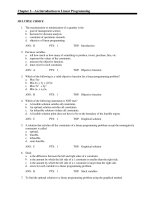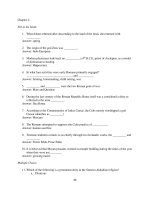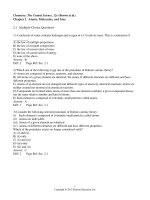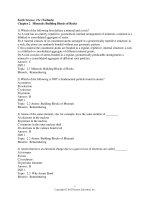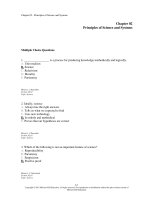Chemistry the central science 13th edition brown test bank
Bạn đang xem bản rút gọn của tài liệu. Xem và tải ngay bản đầy đủ của tài liệu tại đây (667.57 KB, 66 trang )
Chemistry: The Central Science, 13e (Brown et al.)
Chapter 2 Atoms, Molecules, and Ions
2.1 Multiple-Choice Questions
1) A molecule of water contains hydrogen and oxygen in a 1:8 ratio by mass. This is a statement of
________.
A) the law of multiple proportions
B) the law of constant composition
C) the law of conservation of mass
D) the law of conservation of energy
E) none of the above
Answer: B
Diff: 2
Var: 1
Page Ref: Sec. 2.1
LO: 2.1
GO: G2
2) Which one of the following is not one of the postulates of Dalton's atomic theory?
A) Atoms are composed of protons, neutrons, and electrons.
B) All atoms of a given element are identical; the atoms of different elements are different and have
different properties.
C) Atoms of an element are not changed into different types of atoms by chemical reactions: atoms are
neither created nor destroyed in chemical reactions.
D) Compounds are formed when atoms of more than one element combine; a given compound always
has the same relative number and kind of atoms.
E) Each element is composed of extremely small particles called atoms.
Answer: A
Diff: 1
Var: 1
Page Ref: Sec. 2.1
LO: 2.1
GO: G2
3) Consider the following selected postulates of Dalton's atomic theory:
(i) Each element is composed of extremely small particles called atoms.
(ii) Atoms are indivisible.
(iii) Atoms of a given element are identical.
(iv) Atoms of different elements are different and have different properties.
Which of the postulates is(are) no longer considered valid?
A) (i) and (ii)
B) (ii) only
C) (ii) and (iii)
D) (iii) only
E) (iii) and (iv)
Answer: C
Diff: 2
Var: 1
Page Ref: Sec. 2.1
LO: 2.1
GO: G2
1
Copyright © 2015 Pearson Education, Inc.
4) Which pair of substances could be used to illustrate the law of multiple proportions?
A) SO2, H2SO4
B) CO, CO2
C) H2O, O2
D) CH4, C6H12O6
E) NaCl, KCl
Answer: B
Diff: 1
Var: 1
LO: 2.1
GO: G2
Page Ref: Sec. 2.1
5) Which statement below correctly describes the responses of alpha, beta, and gamma radiation to an
electric field?
A) Both beta and gamma are deflected in the same direction, while alpha shows no response.
B) Both alpha and gamma are deflected in the same direction, while beta shows no response.
C) Both alpha and beta are deflected in the same direction, while gamma shows no response.
D) Alpha and beta are deflected in opposite directions, while gamma shows no response.
E) Only alpha is deflected, while beta and gamma show no response.
Answer: D
Diff: 2
Var: 1
Page Ref: Sec. 2.2
LO: 2.2
GO: G2
6) Which one of the following is not true concerning cathode rays?
A) They originate from the negative electrode.
B) They travel in straight lines in the absence of electric or magnetic fields.
C) They impart a negative charge to metals exposed to them.
D) They are made up of electrons.
E) The characteristics of cathode rays depend on the material from which they are emitted.
Answer: E
Diff: 2
Var: 1
Page Ref: Sec. 2.2
LO: 2.2
GO: G2
7) The charge on an electron was determined in the ________.
A) cathode ray tube, by J. J. Thomson
B) Rutherford gold foil experiment
C) Millikan oil drop experiment
D) Dalton atomic theory
E) atomic theory of matter
Answer: C
Diff: 1
Var: 1
Page Ref: Sec. 2.2
LO: 2.2
GO: G2
2
Copyright © 2015 Pearson Education, Inc.
8) ________-rays consist of fast-moving electrons.
A) Alpha
B) Beta
C) Gamma
D) X
E) none of the above
Answer: B
Diff: 1
Var: 1
Page Ref: Sec. 2.2
LO: 2.2
GO: G2
9) The gold foil experiment performed in Rutherford's lab ________.
A) confirmed the plum-pudding model of the atom
B) led to the discovery of the atomic nucleus
C) was the basis for Thomson's model of the atom
D) utilized the deflection of beta particles by gold foil
E) proved the law of multiple proportions
Answer: B
Diff: 1
Var: 1
Page Ref: Sec. 2.2
LO: 2.2
GO: G2
10) In the Rutherford nuclear-atom model, ________.
A) the heavy subatomic particles, protons and neutrons, reside in the nucleus
B) the three principal subatomic particles (protons, neutrons, and electrons) all have essentially the same
mass
C) the light subatomic particles, protons and neutrons, reside in the nucleus
D) mass is spread essentially uniformly throughout the atom
E) the three principal subatomic particles (protons, neutrons, and electrons) all have essentially the same
mass and mass is spread essentially uniformly throughout the atom
Answer: A
Diff: 1
Var: 1
Page Ref: Sec. 2.2
LO: 2.2
GO: G2
11) Cathode rays are ________.
A) neutrons
B) X-rays
C) electrons
D) protons
E) atoms
Answer: C
Diff: 1
Var: 1
Page Ref: Sec. 2.2
LO: 2.2
GO: G2
3
Copyright © 2015 Pearson Education, Inc.
12) Cathode rays are deflected away from a negatively charged plate because ________.
A) they are not particles
B) they are positively charged particles
C) they are neutral particles
D) they are negatively charged particles
E) they are emitted by all matter
Answer: D
Diff: 1
Var: 1
Page Ref: Sec. 2.2
LO: 2.2
GO: G2
13) In the absence of magnetic or electric fields, cathode rays ________.
A) do not exist
B) travel in straight lines
C) cannot be detected
D) become positively charged
E) bend toward a light source
Answer: B
Diff: 1
Var: 1
Page Ref: Sec. 2.2
LO: 2.2
GO: G2
14) Of the three types of radioactivity characterized by Rutherford, which is/are electrically charged?
A) β-rays
B) α-rays and β-rays
C) α-rays, β-rays, and γ-rays
D) α-rays
E) α-rays and γ-rays
Answer: B
Diff: 1
Var: 1
Page Ref: Sec. 2.2
LO: 2.2
GO: G2
15) Of the three types of radioactivity characterized by Rutherford, which is/are not electrically charged?
A) α-rays
B) α-rays, β-rays, and γ-rays
C) γ-rays
D) α-rays and β-rays
E) α-rays and γ-rays
Answer: C
Diff: 1
Var: 1
Page Ref: Sec. 2.2
LO: 2.2
GO: G2
4
Copyright © 2015 Pearson Education, Inc.
16) Of the three types of radioactivity characterized by Rutherford, which are particles?
A) β-rays
B) α-rays, β-rays, and γ-rays
C) γ-rays
D) α-rays and γ-rays
E) α-rays and β-rays
Answer: E
Diff: 1
Var: 1
Page Ref: Sec. 2.2
LO: 2.2
GO: G2
17) Of the three types of radioactivity characterized by Rutherford, which type does not become deflected
by a magnetic field?
A) β-rays
B) α-rays and β-rays
C) α-rays
D) γ-rays
E) α-rays, β-rays, and γ-rays
Answer: D
Diff: 1
Var: 1
Page Ref: Sec. 2.2
LO: 2.2
GO: G2
18) Of the following, the smallest and lightest subatomic particle is the ________.
A) neutron
B) proton
C) electron
D) nucleus
E) alpha particle
Answer: C
Diff: 1
Var: 1
Page Ref: Sec. 2.3
LO: 2.3
GO: G2
19) All atoms of a given element have the same ________.
A) mass
B) number of protons
C) number of neutrons
D) number of electrons and neutrons
E) density
Answer: B
Diff: 1
Var: 1
Page Ref: Sec. 2.3
LO: 2.3
GO: G2
5
Copyright © 2015 Pearson Education, Inc.
20) Which atom has the smallest number of neutrons?
A) carbon-14
B) nitrogen-14
C) oxygen-16
D) fluorine-19
E) neon-20
Answer: B
Diff: 2
Var: 1
Page Ref: Sec. 2.3
LO: 2.3
GO: G2
21) Which atom has the largest number of neutrons?
A) phosphorus-30
B) chlorine-37
C) potassium-39
D) argon-40
E) calcium-40
Answer: D
Diff: 2
Var: 1
Page Ref: Sec. 2.3
LO: 2.3
GO: G2
22) There are ________ electrons, ________ protons, and ________ neutrons in an atom of 132
54 Xe.
A) 132, 132, 54
B) 54, 54, 132
C) 78, 78, 54
D) 54, 54, 78
E) 78, 78, 132
Answer: D
Diff: 2
Var: 1
LO: 2.3
GO: G2
Page Ref: Sec. 2.3
23) An atom of the most common isotope of gold,
________ electrons.
A) 197, 79, 118
B) 118, 79, 39
C) 79, 197, 197
D) 79, 118, 118
E) 79, 118, 79
Answer: E
Diff: 2
Var: 1
Page Ref: Sec. 2.3
LO: 2.3
GO: G2
Au, has ________ protons, ________ neutrons, and
6
Copyright © 2015 Pearson Education, Inc.
63
24) Which combination of protons, neutrons, and electrons is correct for the isotope of copper, 29
Cu
A) 29 p+, 34 n°, 29 eB) 29 p+, 29 n°, 63 eC) 63 p+, 29 n°, 63 eD) 34 p+, 29 n°, 34 eE) 34 p+, 34 n°, 29 eAnswer: A
Diff: 2
Var: 1
Page Ref: Sec. 2.3
LO: 2.3
GO: G2
25) Which isotope has 45 neutrons?
A)
Kr
B)
Br
C)
Se
D)
Cl
E)
Rh
Answer: B
Diff: 2
Var: 1
LO: 2.3
GO: G2
Page Ref: Sec. 2.3
26) Which pair of atoms constitutes a pair of isotopes of the same element?
A)
X
X
B)
X
X
C)
X
X
D)
X
X
E)
X
X
Answer: B
Diff: 1
Var: 1
LO: 2.3
GO: G2
Page Ref: Sec. 2.3
7
Copyright © 2015 Pearson Education, Inc.
27) Which isotope has 36 electrons in an atom?
A)
Kr
B)
Br
C)
Se
D)
Cl
E)
Hg
Answer: A
Diff: 2
Var: 1
LO: 2.3
GO: G2
Page Ref: Sec. 2.3
28) Isotopes are atoms that have the same ________ but differing ________.
A) atomic masses, charges
B) mass numbers, atomic numbers
C) atomic numbers, mass numbers
D) charges, atomic masses
E) mass numbers, charges
Answer: C
Diff: 1
Var: 1
Page Ref: Sec. 2.3
LO: 2.3
GO: G2
29) The nucleus of an atom does not contain ________.
A) protons
B) protons or neutrons
C) neutrons
D) subatomic particles
E) electrons
Answer: E
Diff: 1
Var: 1
Page Ref: Sec. 2.3
LO: 2.3
GO: G2
30) The subatomic particles located in the nucleus with no overall charges are ________.
A) electrons
B) protons
C) neutrons
D) protons and neutrons
E) protons, neutrons, and electrons
Answer: C
Diff: 1
Var: 1
Page Ref: Sec. 2.3
LO: 2.3
GO: G2
8
Copyright © 2015 Pearson Education, Inc.
31) Different isotopes of a particular element contain the same number of ________.
A) protons
B) neutrons
C) protons and neutrons
D) protons, neutrons, and electrons
E) subatomic particles
Answer: A
Diff: 1
Var: 1
Page Ref: Sec. 2.3
LO: 2.3
GO: G2
32) Different isotopes of a particular element contain different numbers of ________.
A) protons
B) neutrons
C) protons and neutrons
D) protons, neutrons, and electrons
E) None of the above is correct.
Answer: B
Diff: 1
Var: 1
Page Ref: Sec. 2.3
LO: 2.3
GO: G2
33) In the symbol shown below, x = ________.
C
A) 7
B) 13
C) 12
D) 6
E) not enough information to determine
Answer: D
Diff: 2
Var: 1
Page Ref: Sec. 2.3
LO: 2.3
GO: G2
34) In the symbol below, X = ________.
X
A) N
B) C
C) Al
D) K
E) not enough information to determine
Answer: B
Diff: 2
Var: 1
Page Ref: Sec. 2.3
LO: 2.3
GO: G2
9
Copyright © 2015 Pearson Education, Inc.
35) In the symbol below, x = ________.
O
A) 17
B) 8
C) 6
D) 7
E) not enough information to determine
Answer: E
Diff: 2
Var: 1
Page Ref: Sec. 2.3
LO: 2.3
GO: G2
36) In the symbol below, x is ________.
C
A) the number of neutrons
B) the atomic number
C) the mass number
D) the isotope number
E) the elemental symbol
Answer: C
Diff: 1
Var: 1
Page Ref: Sec. 2.3
LO: 2.3
GO: G2
37) Which one of the following basic forces is so small that it has no chemical significance?
A) weak nuclear force
B) strong nuclear force
C) electromagnetism
D) gravity
E) Coulomb's law
Answer: D
Diff: 2
Var: 1
Page Ref: Sec. 2.3
LO: 2.3
GO: G2
38) Gravitational forces act between objects in proportion to their ________.
A) volumes
B) masses
C) charges
D) polarizability
E) densities
Answer: B
Diff: 1
Var: 1
Page Ref: Sec. 2.3
LO: 2.3
GO: G2
10
Copyright © 2015 Pearson Education, Inc.
39) Silver has two naturally occurring isotopes with the following isotopic masses:
Ar
106.90509
Ar
108.9047
The average atomic mass of silver is 107.8682 amu. The fractional abundance of the lighter of the two
isotopes is ________.
A) 0.24221
B) 0.48168
C) 0.51835
D) 0.75783
E) 0.90474
Answer: C
Diff: 4
Var: 1
Page Ref: Sec. 2.4
LO: 2.4
GO: G4
40) The atomic mass unit is presently based on assigning an exact integral mass (in amu) to an isotope of
________.
A) hydrogen
B) oxygen
C) sodium
D) carbon
E) helium
Answer: D
Diff: 1
Var: 1
Page Ref: Sec. 2.4
LO: 2.4
GO: G4
41) The element X has three naturally occurring isotopes. The masses (amu) and % abundances of the
isotopes are given in the table below. The average atomic mass of the element is ________ amu.
A) 219.7
B) 220.4
C) 220.42
D) 218.5
E) 221.0
Answer: B
Diff: 3
Var: 1
LO: 2.4
GO: G4
Page Ref: Sec. 2.4
11
Copyright © 2015 Pearson Education, Inc.
42) Element X has three naturally occurring isotopes. The masses (amu) and % abundances of the isotopes
are given in the table below. The average atomic mass of the element is ________ amu.
A) 41.54
B) 39.68
C) 39.07
D) 38.64
E) 33.33
Answer: A
Diff: 3
Var: 1
LO: 2.4
GO: G4
Page Ref: Sec. 2.4
43) The element X has three naturally occurring isotopes. The isotopic masses (amu) and % abundances of
the isotopes are given in the table below. The average atomic mass of the element is ________ amu.
A) 161.75
B) 162.03
C) 162.35
D) 163.15
E) 33.33
Answer: C
Diff: 3
Var: 1
LO: 2.4
GO: G4
Page Ref: Sec. 2.4
12
Copyright © 2015 Pearson Education, Inc.
44) The element X has three naturally occurring isotopes. The isotopic masses (amu) and % abundances of
the isotopes are given in the table below. The average atomic mass of the element is ________ amu.
A) 33.33
B) 55.74
C) 56.11
D) 57.23
E) 56.29
Answer: C
Diff: 3
Var: 1
LO: 2.4
GO: G4
Page Ref: Sec. 2.4
45) The element X has two naturally occurring isotopes. The masses (amu) and % abundances of the
isotopes are given in the table below. The average atomic mass of the element is ________ amu.
A) 30.20
B) 33.20
C) 34.02
D) 35.22
E) 32.73
Answer: B
Diff: 3
Var: 1
LO: 2.4
GO: G4
Page Ref: Sec. 2.4
46) The average atomic weight of copper, which has two naturally occurring isotopes, is 63.5. One of the
isotopes has an atomic weight of 62.9 amu and constitutes 69.1% of the copper isotopes. The other isotope
has an abundance of 30.9%. The atomic weight (amu) of the second isotope is ________ amu.
A) 63.2
B) 63.8
C) 64.1
D) 64.8
E) 28.1
Answer: D
Diff: 4
Var: 1
Page Ref: Sec. 2.4
LO: 2.4
GO: G4
13
Copyright © 2015 Pearson Education, Inc.
47) The element X has three naturally occurring isotopes. The masses (amu) and % abundances of the
isotopes are given in the table below. The average atomic mass of the element is ________ amu.
A) 17.20
B) 16.90
C) 17.65
D) 17.11
E) 16.90
Answer: A
Diff: 3
Var: 1
LO: 2.4
GO: G4
Page Ref: Sec. 2.4
48) Vanadium has two naturally occurring isotopes, 50V with an atomic mass of 49.9472 amu and 51V
with an atomic mass of 50.9440. The atomic weight of vanadium is 50.9415. The percent abundances of
the vanadium isotopes are ________% 50V and ________% 51V.
A) 0.25, 99.75
B) 99.75, 0.25
C) 49, 51
D) 1.0, 99
E) 99, 1.0
Answer: A
Diff: 4
Var: 1
LO: 2.4
GO: G4
Page Ref: Sec. 2.4
49) An unknown element is found to have three naturally occurring isotopes with atomic masses of
35.9675 (0.337%), 37.9627 (0.063%), and 39.9624 (99.600%). Which of the following is the unknown
element?
A) Ar
B) K
C) Cl
D) Ca
E) None of the above could be the unknown element.
Answer: A
Diff: 2
Var: 1
Page Ref: Sec. 2.4
LO: 2.4
GO: G4
14
Copyright © 2015 Pearson Education, Inc.
50) In the periodic table, the elements are arranged in ________.
A) alphabetical order
B) order of increasing atomic number
C) order of increasing metallic properties
D) order of increasing neutron content
E) reverse alphabetical order
Answer: B
Diff: 1
Var: 1
Page Ref: Sec. 2.5
LO: 2.5
GO: G2
51) Elements ________ exhibit similar physical and chemical properties.
A) with similar chemical symbols
B) with similar atomic masses
C) in the same period of the periodic table
D) on opposite sides of the periodic table
E) in the same group of the periodic table
Answer: E
Diff: 1
Var: 1
Page Ref: Sec. 2.5
LO: 2.5
GO: G2
52) Which pair of elements would you expect to exhibit the greatest similarity in their physical and
chemical properties?
A) H, Li
B) Cs, Ba
C) Ca, Sr
D) Ga, Ge
E) C, O
Answer: C
Diff: 1
Var: 1
Page Ref: Sec. 2.5
LO: 2.5
GO: G2
53) Which pair of elements would you expect to exhibit the greatest similarity in their physical and
chemical properties?
A) O, S
B) C, N
C) K, Ca
D) H, He
E) Si, P
Answer: A
Diff: 1
Var: 1
Page Ref: Sec. 2.5
LO: 2.5
GO: G2
15
Copyright © 2015 Pearson Education, Inc.
54) Which pair of elements would you expect to exhibit the greatest similarity in their physical and
chemical properties?
A) As, Br
B) Mg, Al
C) I, At
D) Br, Kr
E) N,O
Answer: C
Diff: 1
Var: 1
Page Ref: Sec. 2.5
LO: 2.5
GO: G2
55) The elements in groups 1A, 6A, and 7A are called ________, respectively.
A) alkaline earth metals, halogens, and chalcogens
B) alkali metals, chalcogens, and halogens
C) alkali metals, halogens, and noble gases
D) alkaline earth metals, transition metals, and halogens
E) halogens, transition metals, and alkali metals
Answer: B
Diff: 2
Var: 1
Page Ref: Sec. 2.5
LO: 2.5
GO: G2
56) Which pair of elements below should be the most similar in chemical properties?
A) C and O
B) B and As
C) I and Br
D) K and Kr
E) Cs and He
Answer: C
Diff: 1
Var: 1
Page Ref: Sec. 2.5
LO: 2.5
GO: G2
57) An element in the upper right corner of the periodic table ________.
A) is either a metal or metalloid
B) is definitely a metal
C) is either a metalloid or a nonmetal
D) is definitely a nonmetal
E) is definitely a metalloid
Answer: D
Diff: 1
Var: 1
Page Ref: Sec. 2.5
LO: 2.5
GO: G2
16
Copyright © 2015 Pearson Education, Inc.
58) An element that appears in the lower left corner of the periodic table is ________.
A) either a metal or metalloid
B) definitely a metal
C) either a metalloid or a nonmetal
D) definitely a nonmetal
E) definitely a metalloid
Answer: B
Diff: 1
Var: 1
Page Ref: Sec. 2.5
LO: 2.5
GO: G2
59) Elements in the same group of the periodic table typically have ________.
A) similar mass numbers
B) similar physical properties only
C) similar chemical properties only
D) similar atomic masses
E) similar physical and chemical properties
Answer: E
Diff: 1
Var: 1
Page Ref: Sec. 2.5
LO: 2.5
GO: G2
60) Which one of the following molecular formulas is also an empirical formula?
A) C6H6O2
B) C2H6SO
C) H2O2
D) H2P4O6
E) C6H6
Answer: B
Diff: 2
Var: 1
LO: 2.6
GO: G2
Page Ref: Sec. 2.6
61) Which compounds do not have the same empirical formula?
A) C2H2, C6H6
B) CO, CO2
C) C2H4, C3H6
D) C2H4O2, C6H12O6
E) C2H5COOCH3, CH3CHO
Answer: B
Diff: 2
Var: 1
LO: 2.6
GO: G2
Page Ref: Sec. 2.6
17
Copyright © 2015 Pearson Education, Inc.
62) Of the choices below, which one is not an ionic compound?
A) PCl5
B) MoCl6
C) RbCl
D) PbCl2
E) NaCl
Answer: A
Diff: 1
Var: 1
LO: 2.6
GO: G2
Page Ref: Sec. 2.6
63) Which type of formula provides the most information about a compound?
A) empirical
B) molecular
C) simplest
D) structural
E) chemical
Answer: D
Diff: 1
Var: 1
Page Ref: Sec. 2.6
LO: 2.6
GO: G2
64) A molecular formula always indicates ________.
A) how many of each atom are in a molecule
B) the simplest whole-number ratio of different atoms in a compound
C) which atoms are attached to which in a molecule
D) the isotope of each element in a compound
E) the geometry of a molecule
Answer: A
Diff: 1
Var: 1
Page Ref: Sec. 2.6
LO: 2.6
GO: G2
65) An empirical formula always indicates ________.
A) which atoms are attached to which in a molecule
B) how many of each atom are in a molecule
C) the simplest whole-number ratio of different atoms in a compound
D) the isotope of each element in a compound
E) the geometry of a molecule
Answer: C
Diff: 1
Var: 1
Page Ref: Sec. 2.6
LO: 2.6
GO: G2
18
Copyright © 2015 Pearson Education, Inc.
66) The molecular formula of a compound is always ________ the empirical formula.
A) more complex than
B) different from
C) an integral multiple of
D) the same as
E) simpler than
Answer: C
Diff: 1
Var: 1
Page Ref: Sec. 2.6
LO: 2.6
GO: G2
67) Formulas that show how atoms are attached in a molecule are called ________.
A) molecular formulas
B) ionic formulas
C) empirical formulas
D) diatomic formulas
E) structural formulas
Answer: E
Diff: 1
Var: 1
Page Ref: Sec. 2.6
LO: 2.6
GO: G2
68) Of the following, ________ contains the greatest number of electrons.
A) P3+
B) P
C) P2D) P3E) P2+
Answer: D
Diff: 2
Var: 1
LO: 2.7
GO: G2
Page Ref: Sec. 2.7
19
Copyright © 2015 Pearson Education, Inc.
69) Which species has 54 electrons?
A)
Xe+
B)
Te2-
C)
Sn2+
D)
Cd
E)
Xe2+
Answer: B
Diff: 2
Var: 1
LO: 2.7
GO: G2
Page Ref: Sec. 2.7
70) Which species has 16 protons?
A) 31P
B) 34S2C) 36Cl
D) 80BrE) 16O
Answer: B
Diff: 2
Var: 1
LO: 2.7
GO: G2
Page Ref: Sec. 2.7
71) Which species has 18 electrons?
A) 39K
B) 32S2C) 35Cl
D) 27Al3+
E) 64Cu2+
Answer: B
Diff: 2
Var: 1
LO: 2.7
GO: G2
Page Ref: Sec 2.7
20
Copyright © 2015 Pearson Education, Inc.
72) The species ________ contains 16 neutrons.
A) 31P
B) 34S2C) 36Cl
D) 80BrE) 16O
Answer: A
Diff: 2
Var: 1
LO: 2.7
GO: G2
Page Ref: Sec. 2.7
73) Which species is an isotope of 39Cl?
A) 40Ar+
B) 34S2C) 36ClD) 80Br
E) 39Ar
Answer: C
Diff: 1
Var: 1
LO: 2.7
GO: G2
Page Ref: Sec. 2.7
74) Which one of the following species has as many electrons as it has neutrons?
A) 1H
B) 40Ca2+
C) 14C
D) 19FE) 14C2+
Answer: D
Diff: 2
Var: 1
LO: 2.7
GO: G2
Page Ref: Sec. 2.7
75) There are ________ protons, ________ neutrons, and ________ electrons in
A) 131, 53, 54
B) 131, 53, 52
C) 53, 78, 54
D) 53, 131, 52
E) 78, 53, 72
Answer: C
Diff: 2
Var: 1
Page Ref: Sec. 2.7
LO: 2.7
GO: G2
21
Copyright © 2015 Pearson Education, Inc.
I- .
76) There are ________ protons, ________ neutrons, and ________ electrons in
A) 146, 92, 92
B) 92, 146, 87
C) 92, 146, 92
D) 92, 92, 87
E) 146, 92, 146
Answer: B
Diff: 2
Var: 1
Page Ref: Sec. 2.7
LO: 2.7
GO: G2
77) Which species has 48 electrons?
A)
Sn+2
B)
Sn+4
C)
Cd+2
D)
Ga
E)
Ti
Answer: A
Diff: 1
Var: 1
LO: 2.7
GO: G2
Page Ref: Sec. 2.7
78) Which of the following compounds would you expect to be ionic?
A) H2O
B) CO2
C) SrCl2
D) SO2
E) H2S
Answer: C
Diff: 1
Var: 1
LO: 2.6
GO: G2
Page Ref: Sec. 2.7
22
Copyright © 2015 Pearson Education, Inc.
U+5.
79) Which pair of elements is most apt to form an ionic compound with each other?
A) barium, bromine
B) calcium, sodium
C) oxygen, fluorine
D) sulfur, fluorine
E) nitrogen, hydrogen
Answer: A
Diff: 1
Var: 1
Page Ref: Sec. 2.7
LO: 2.7
GO: G2
80) Which pair of elements is most apt to form a molecular compound with each other?
A) aluminum, oxygen
B) magnesium, iodine
C) sulfur, fluorine
D) potassium, lithium
E) barium, bromine
Answer: C
Diff: 1
Var: 1
Page Ref: Sec. 2.7
LO: 2.7
GO: G2
81) Which species below is the nitride ion?
A) Na+
B) NO3C) NO2D) NH4+
E) N3Answer: E
Diff: 2
Var: 1
LO: 2.8
GO: G2
Page Ref: Sec. 2.8
82) Barium reacts with a polyatomic ion to form a compound with the general formula Ba3(X)2. What
would be the most likely formula for the compound formed between sodium and the polyatomic ion X?
A) NaX
B) Na2X
C) Na2X2
D) Na3X
E) Na3X2
Answer: D
Diff: 2
Var: 1
LO: 2.8
GO: G2
Page Ref: Sec. 2.8
23
Copyright © 2015 Pearson Education, Inc.
83) Aluminum reacts with a certain nonmetallic element to form a compound with the general formula
Al2X3. Element X must be from Group ________ of the Periodic Table of Elements.
A) 3A
B) 4A
C) 5A
D) 6A
E) 7A
Answer: D
Diff: 2
Var: 1
LO: 2.8
GO: G2
Page Ref: Sec. 2.8
84) The formula for a salt is XBr. The X-ion in this salt has 46 electrons. The metal X is ________.
A) Ag
B) Pd
C) Cd
D) Cu
E) Cs
Answer: A
Diff: 2
Var: 1
Page Ref: Sec. 2.8
LO: 2.8
GO: G2
85) Which formula/name pair is incorrect?
A) Mn(NO2)2
manganese(II) nitrite
B) Mg(NO3)2
magnesium nitrate
C) Mn(NO3)2
manganese(II) nitrate
D) Mg3N2
magnesium nitrite
E) Mg(MnO4)2
magnesium permanganate
Answer: D
Diff: 2
Var: 1
LO: 2.8
GO: G2
Page Ref: Sec. 2.8
86) Which formula/name pair is incorrect?
A) FeSO4
iron(II) sulfate
B) Fe2(SO3)3
iron(III) sulfite
C) FeS
D) FeSO3
iron(II) sulfide
iron(II) sulfite
E) Fe2(SO4)3
iron(III) sulfide
Answer: E
Diff: 2
Var: 1
LO: 2.8
GO: G2
Page Ref: Sec. 2.8
24
Copyright © 2015 Pearson Education, Inc.
87) Which one of the following is the formula of hydrochloric acid?
A) HClO3
B) HClO4
C) HClO
D) HCl
E) HClO2
Answer: D
Diff: 2
Var: 1
LO: 2.8
GO: G2
Page Ref: Sec. 2.8
88) The suffix -ide is used primarily ________.
A) for monatomic anion names
B) for polyatomic cation names
C) for the name of the first element in a molecular compound
D) to indicate binary acids
E) for monoatomic cations
Answer: A
Diff: 2
Var: 1
Page Ref: Sec. 2.8
LO: 2.8
GO: G2
89) Which one of the following compounds is chromium(III) oxide?
A) Cr2O3
B) CrO3
C) Cr3O2
D) Cr3O
E) Cr2O4
Answer: A
Diff: 1
Var: 1
LO: 2.8
GO: G2
Page Ref: Sec. 2.8
90) Which one of the following compounds is copper(I) chloride?
A) CuCl
B) CuCl2
C) Cu2Cl
D) Cu2Cl3
E) Cu3Cl2
Answer: A
Diff: 1
Var: 1
LO: 2.8
GO: G2
Page Ref: Sec. 2.8
25
Copyright © 2015 Pearson Education, Inc.


